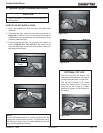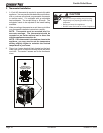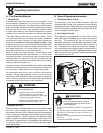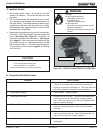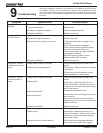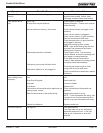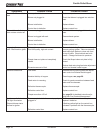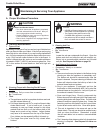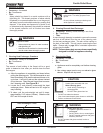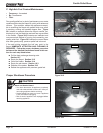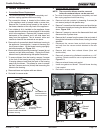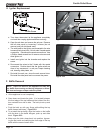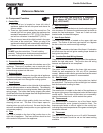
R
R
R
October 11,, 2005
250-6422D
Page 27
Castile Pellet Stove
10
Maintaining & Servicing Your Appliance
Figure 27.1 - Large Clinker
3. Cleaning Ash Pan
• Frequency: As needed
• By:
Homeowner
• Task:
Locate the ash pan underneath the firepot. Open the
bottom ash door and slide the ash pan straight out.
Empty into a noncombustible container and re-install
ash pan. See Disposal of Ashes on page 28.
4. Ash Removal from Firebox
• Frequency: Weekly or as needed
• By:
Homeowner
• Task:
a. There must not be any hot ashes in the firebox during
cleaning so allow the appliance to completely cool.
The firebox ash should be removed every time the
firepot is cleaned. Frequent cleaning of the ash in the
firebox will help slow down the build-up of ash in the
exhaust blower and vent system.
b. Plug in your appliance, if unplugged, and turn the
thermostat on and immediatley shut it off to start the
exhaust blower on its cycle time. It will pull fly ash out
the exhaust instead of into the room.
c. Open cast hinged face. Directly underneath the
firebox door and to the left and right of the firepot are 2
cleaning slide plates with finger holes. Pull both slide
plates out and then open the glass door. Sweep the
remaining ash from the firebox into the 2 open holes.
A paint brush works well for this. Close slide plates.
d. This ash is deposited in the same ash pan as the
firepot debris. The ash pan should be emptied every
time you clean the firebox. Remember to place
the ash and debris into a metal or noncombustible
container.
e. The 2 cleaning slide plates must be fully closed when
cleaning is complete. See Disposal of Ashes on
page 28.
B. General Maintenance
1. Types of Fuel
Depending on the type of fuel you are burning will dictate how
often you have to clean your firepot. If the fuel you are burning
has a high dirt or ash content or you are burning shelled field
corn, it may be necessary to clean the firepot more than once
a day. Dirty fuel will cause clinkers to form in the firepot. A
clinker is formed when dirt, ash or a non-burnable substance
is heated to 2000°F (1093°C) and becomes glass-like. See
“C” in this section for more details on fuels with high ash
content.
2. Cleaning Firepot with Cleaning Rod & Firepot
Scraper
• Frequency:
Daily or more often as needed
• By: Homeowner
• Task:
a. The appliance must be in complete shutdown and cool
and the exhaust blower off.
b. Pull firepot cleaning rod OUT a couple of times to help
shake debris loose. If rod is hard to pull, it may be
necessary to use your firepot scraper to chip away
material that has built up on the bottom plate of the
firepot and to push out any clinkers. Larger clinkers
may have to be removed from the top of the firepot.
Corn clinkers can be especially difficult to break up.
c. The firepot floor plate must be fully closed when
finished.
Clinker
WARNING
• NEVER pull firepot cleaning rod or cleaning
slide plates out when appliance is operating.
• The cleaning slide plates must be fully
CLOSED when appliance is operating.
•. Hot pellets may fall into ashpan and start a
fire or mis-starts due to lack of vacuum.
Fire Risk
Shock and Smoke Hazard
• Turn down thermostat, let appliance completely
cool and exhaust blower must be off. Now you
can unplug appliance before servicing.
• Smoke spillage into room can occur if appliance
is not cool before unplugging.
• Risk of shock if appliance not unplugged before
servicing appliance.
CAUTION
A. Proper Shutdown Procedure



